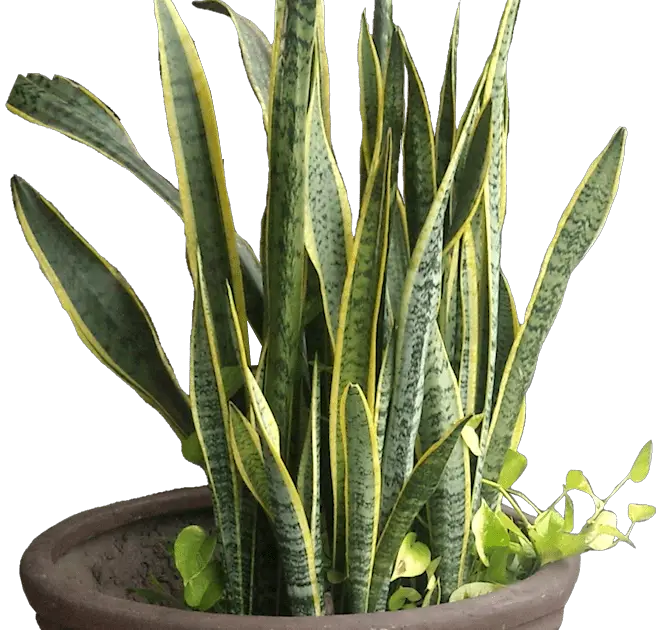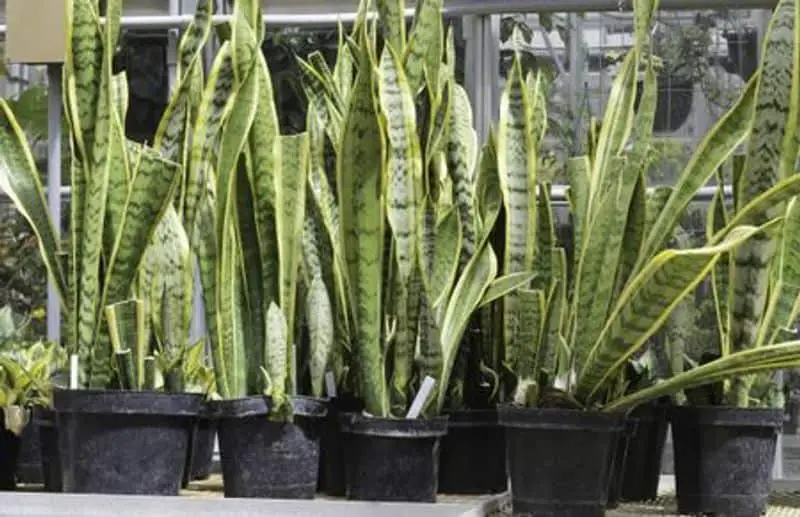This post contains affiliate links. If you buy something from one of our links we may earn a commission. Thanks

Do you have a snake plant in your home? Thinking about buying one? Indoor snake plant care is important to keep your plants healthy and thriving.
Snake Plant Care Key Takeaways:
- Indoor Snake Plant Care involves watering the plant only when the soil is completely dry.
- Provide bright, indirect sunlight, and fertilize sparingly, perhaps annually with a cactus fertilizer.
- The temperature should be kept above 50 degrees Fahrenheit.
- Although snake plants are pest-resistant, occasional checks for spider mites and mealybugs are beneficial for a healthy plant.
In this blog post, we will discuss the best way to care for your indoor snake plant.
We will cover everything from watering to fertilizing to light requirements. Keep reading for more information on how to keep your snake plant healthy and happy!
What Is A Snake Plant
Before we get started on caring for our snake plant we should get a bit of information about the plant itself.
It is most commonly known as the snake plant. Until 2017, it was known under the synonym Sansevieria trifasciata
It is an evergreen perennial plant forming dense stands, spreading by way of its creeping rhizome, which is sometimes above ground, sometimes underground.
Its stiff leaves grow vertically from a basal rosette. Mature leaves are dark green with light gray-green cross-banding and usually range from 70–90 centimetres (2.3–3.0 ft) long and 5–6 centimetres (2.0–2.4 in) wide, though it can reach heights above 2 m (6 ft) in optimal conditions. Dracaena trifasciata – Wikipedia
The snake plant formerly Sansevieria trifasciata and renamed Dracaena trifasciata is a hardy, resilient houseplant that can tolerate a wide range of growing conditions.
It is often recommended as a plant for beginners, as it is very difficult to kill.
While this is true I think you want your plant to flourish and not just survive. So let’s learn a bit about indoor snake plant care,
Indoor Snake Plant Care

Watering Snake Plants
Watering is one of the most important aspects of indoor snake plant care. These plants are drought tolerant and can survive long periods without water
Snake plants are one of the most drought-tolerant houseplants around, which means they’re perfect for those who are forgetful when it comes to watering their plants.
However, that doesn’t mean that they don’t need any water at all.
During the growing season in spring and summer, snake plants should be watered about once a week, allowing the soil to dry out completely between watering.
In the fall and winter, you can reduce the frequency of watering to every other week or even once a month.
When you do water your snake plant, make sure to use lukewarm water; cold water can shock the roots and cause damage.
Snake Plant Light Requirements
Snake plants are native to Africa, and in their natural habitat, they grow in partial shade.
However, when grown as a houseplant they will thrive in almost any light conditions, from full sun to low, indirect light.
The snake plant, also known as the mother-in-law’s tongue, is a popular houseplant that is known for its easy care requirements.
One of the snake plant’s most notable features is its tolerance for low light conditions.
In fact, the plant will actually benefit from being grown in an area with little to no direct sunlight.
This makes the snake plant an ideal choice for those who want to add a touch of greenery to a room that doesn’t get much natural light.
The snake plant will also do well in bright light conditions, but it is important to avoid direct sunlight, as this can scorch the leaves.
But if you acclimate them gradually they can take the direct sun several hours a day.
With its tolerant nature and striking appearance, it’s no wonder the snake plant is such a popular houseplant choice.
Fertilizing Indoor Snake Plants
Snake plants are a popular choice for indoor gardens because they’re low-maintenance and easy to care for.
However, even tough plants like snake plants need a little help to stay healthy and thrive.
One way to give your snake plant a boost is to fertilize it regularly. Fertilizer provides the nutrients that plants need to grow, and can help snake plants to produce more vibrant leaves and flowers.
When choosing a fertilizer for your snake plant, look for one that is specifically formulated for use on indoor plants.
Cactus fertilizer should work very well. Follow the instructions on the packaging carefully, as too much fertilizer can actually damage your plant.
So when it comes to fertilizing, indoor snake plants don’t need much. Less is often more. In fact, you can fertilize them once a year or every other year and they will be just fine.
Indoor Snake Plant Temperature
Most people think of desertscapes when they think of snake plants, but these resilient plants can actually thrive indoors in a variety of climates.
One important factor to consider when growing snake plants indoors is temperature. Snake plants prefer warm environments and will languish in temperatures below 50 degrees Fahrenheit.
If you live in a particularly cold climate, you may need to provide supplemental heat for your snake plant by placing it near a radiator or using a grow light. The snake plant enjoys a warm and comfortable indoor climate.
As far as temperature goes, indoor snake plants prefer room temperatures that are between 70 and 90 degrees Fahrenheit.
They have a low tolerance for cold and temperatures below 50 are harmful.
Although they can tolerate higher or lower temperatures for short periods of time, they will not thrive in extreme conditions.
If you notice your plant looking wilted or stressed, check the temperature of the room it is in to make sure it is within the ideal range.
Humidity For Snake Plants
Snake plants are adapted to living in dry climates. They prefer a humidity level of about 40%.
Snake plants are very adaptable but if humidity is very high you may try to reduce watering to keep it down.
Snake Plant Pests
One of the great things about snake plants is that they are relatively resistant to pests.
However, there are a few common pests that can cause problems for your plant. Spider mites and mealybugs are two of the most common pests that affect snake plants. Both of these pests sucked the fluids from the leaves of the plant, causing them to turn yellow or brown.
If you notice any of these pests on your plant, you can remove them by wiping them off with a damp cloth.
You can also treat your plant with an insecticidal soap or neem oil to help prevent further infestations.
Propagating Snake Plants Indoors
Propagating indoor snake plants is easy to do and can be done by division or leaf cuttings.
To propagate by division, simply divide the plant into two or more sections and pot each section up in its own pot.
Snake plants also produce pups. The plant’s rhizomes will produce offshoots.
You can remove these with a sharp clean knife or shears and replant them into a new pot.
To propagate by leaf cuttings, cut a healthy leaf from the plant and place it in a pot of moistened soil. Keep the soil moist and within a few weeks, you should see new growth!
Repotting Snake Plants
Snake plants are tough plants that can tolerate a wide range of growing conditions.
However, they will eventually outgrow their pot and will need to be repotted.
The best time to repot your snake plant is in the spring before the plant starts its active growth period.
To repot your snake plant, start by carefully removing it from its current pot.
If the roots are tightly bound, you may need to gently loosen them with your fingers.
Next, choose a new pot that is slightly larger than the old one and has drainage holes.
You can fill the bottom of the pot with a layer of gravel or coarse sand to help with drainage.
Then, add a high-quality potting mix and transplant your snake plant.
Water thoroughly and give the plant some time to adjust to its new home before fertilizing.
When it comes to repotting, indoor snake plants don’t need to be repotted often. In fact, they can sometimes go several years without being repotted.
Are Snake Plants Poisonous?
Last but not least, indoor snake plants are not safe for pets, If your pet is prone to chewing on plants, you may want to keep them out of reach.
Snake plants contain saponins, which can cause vomiting and diarrhea in pets if they consume too much of it.
Snake Plant Care FAQs
The Snake Plant, or Dracaena trifasciata, is a delightful addition to the indoor green space, heralded for its robust nature and striking aesthetics.
However, like any plant, it has its preferences in terms of care to truly thrive.
Common inquiries often revolve around its watering, light, and fertilization needs, along with its temperament towards pests.
Here, we’ll address some of these queries to ensure your Snake Plant continues to adorn your living or workspace with its presence.
Q. How often should I water my Snake Plant?
A. Water your Snake Plant only when the soil is completely dry, which is typically once every 2-6 weeks.
Over-watering is a common mistake, so it’s crucial to check the soil moisture before adding water.
Q. What kind of light is best for a Snake Plant?
A. Snake Plants thrive in bright, indirect light but can tolerate low-light conditions as well. It’s best to avoid direct sunlight as it can scorch the leaves.
Q. Is fertilizing necessary for Snake Plants?
A. While not mandatory, a yearly application of a mild cactus fertilizer during the growing season can benefit your Snake Plant. Over-fertilization should be avoided.
Q. What should I do if my Snake Plant has pests?
A. Though snake plants are resistant to most pests, infestations can be treated by wiping the pests off with a damp cloth or using insecticidal soap or neem oil as a preventive measure.
Armed with the answers to these common questions, you are well on your way to mastering the art of Snake Plant care, ensuring a healthy and visually appealing green companion in your indoor spaces.
Indoor Snake Plant Care Final Thoughts
Now that you know all about indoor snake plant care, you can be sure that your plant will thrive!
Just remember to water regularly, provide bright but indirect light, and fertilize once a year.
With proper care, your indoor snake plant will grow healthy and strong for many years to come!
Not sure is you want to keep houseplants? This article may help: Benefits Of Keeping Indoor Plants For Improved Lifestyle (indoorvegetablegrower.com)





